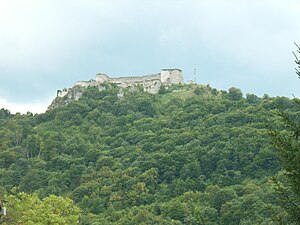Ostrovica Castle
| Ostrovica Castle | ||
|---|---|---|
|
View of the ruined castle which is located on a wooded mountain |
||
| Creation time : | 15th century | |
| Castle type : | Kammburg | |
| Conservation status: | ruin | |
| Standing position : | Nobles | |
| Construction: | Ashlar | |
| Place: | Ostrovica , Bihać Municipality , Bosnia and Herzegovina | |
| Geographical location | 44 ° 33 '32 " N , 16 ° 4' 23" E | |
|
|
||
The ostrovica castle [ Ostrowitza ] is a medieval castle above the eponymous village near the town of Kulen Vakuf in the town of Bihac , western Bosnia and Herzegovina . Only ruins remain of the former extensive fortified castle complex.
location
Surrounded by forests , the castle is located on a ridge above the Una river not far from Kulen Vakuf, where the river is shallow and there is a bridge. The favorable strategic location has allowed the castle owners to control the trade and military routes that ran through the river valley for several centuries.
history
The castle was first mentioned in the 15th century as a fortification of the Croatian noble family Kurjaković , known as the Prince of Krbava , from whose Ivan Karlović (Latin: Iohannes Torquatus), who later became the Ban (viceroy) of Croatia, emerged. At the end of the 15th century, the castle was owned by the nobleman Juraj Mikulčić, who died in 1495. The owners of the castle were also members of the Frankopan family and Ivan Keglević .
During the constant Croatian - Ottoman wars in the second half of the 15th and the beginning of the 16th century (especially after the fall of the Kingdom of Bosnia under Ottoman rule in 1463) the pressure of the Ottoman conquerors on the castle increased. Ostrovica finally fell in December 1523 and became part of the Paschaluk of Bosnia until it was occupied by Austria-Hungary in 1878.
Under Ottoman rule, the castle became an important border stronghold in north-western Bosnia. It was expanded and fortified, and initially commanded by a "disdar" or castellan (in the 16th and 17th centuries), then (from the end of the 17th century) even by a "captain" or captain . The castle received its final shape at the beginning of the 18th century. It is 117 meters long and 83 meters wide.
Ostrovica was in Habsburg hands from 1878 until it became part of the Kingdom of Serbs, Croats and Slovenes (later Yugoslavia) in 1918 . Today the ruin belongs to the Una National Park in Bosnia and Herzegovina .

